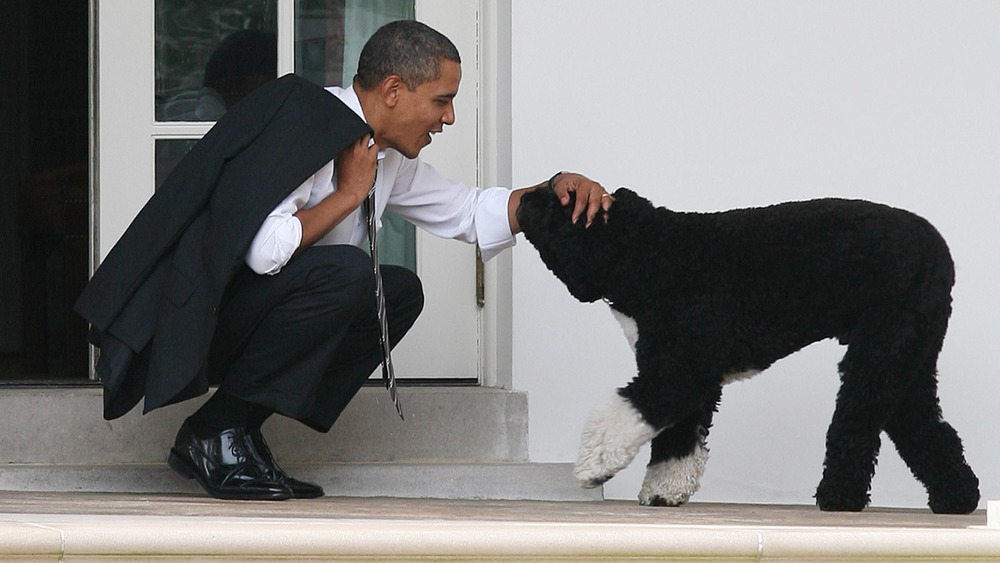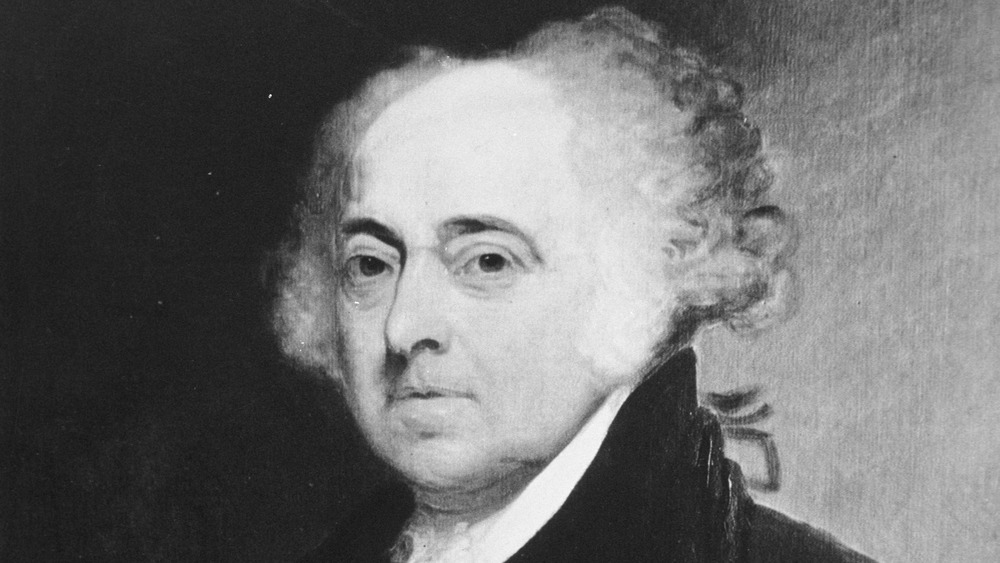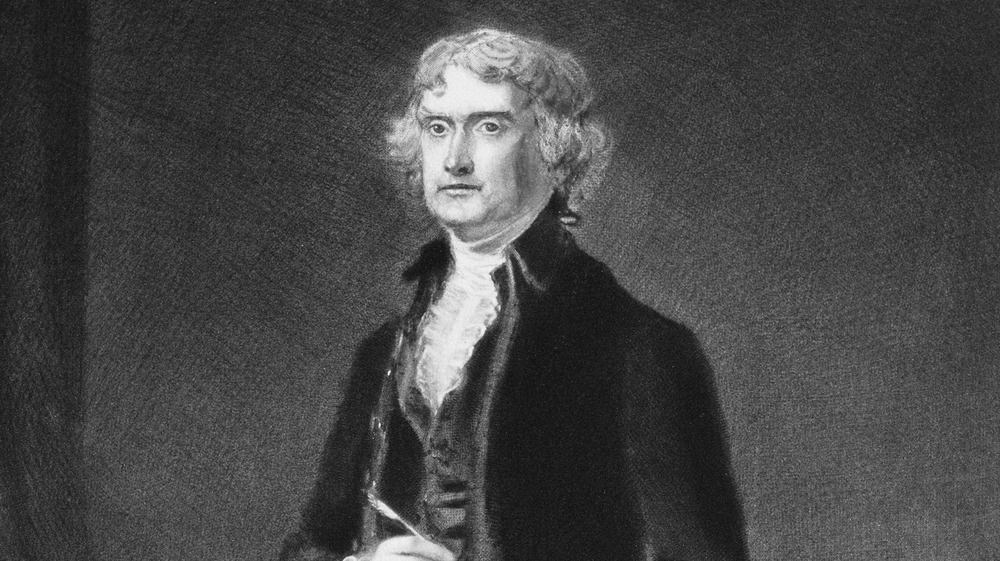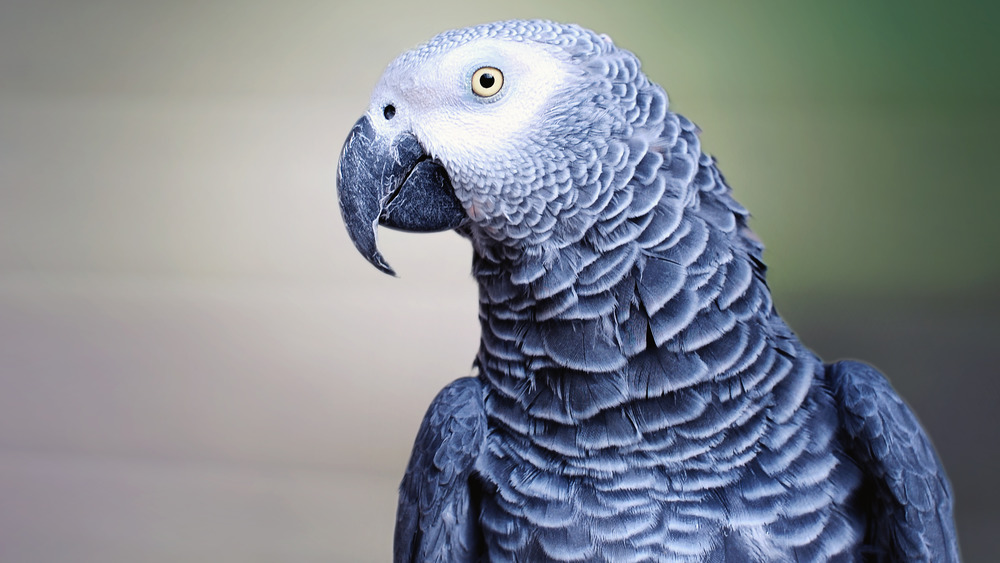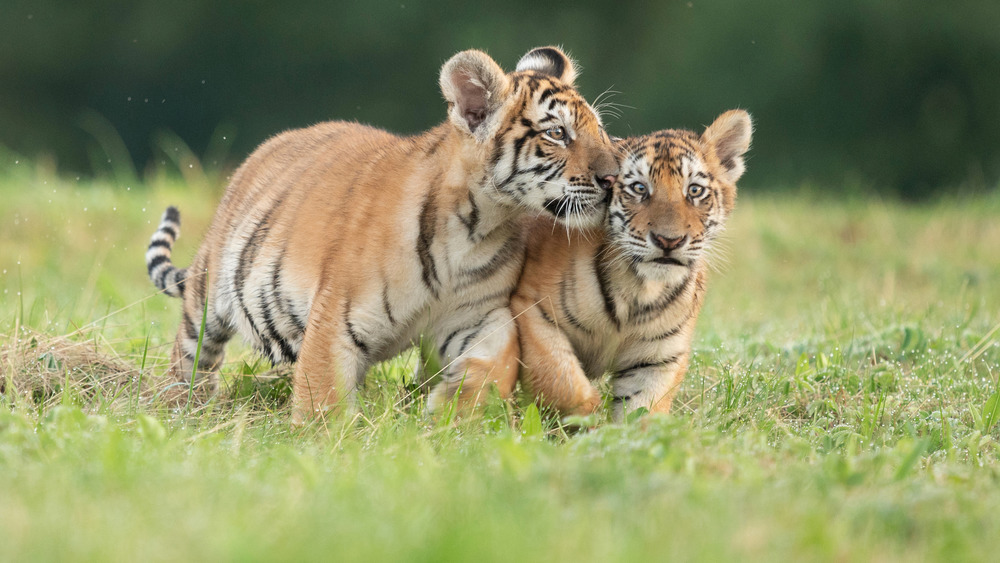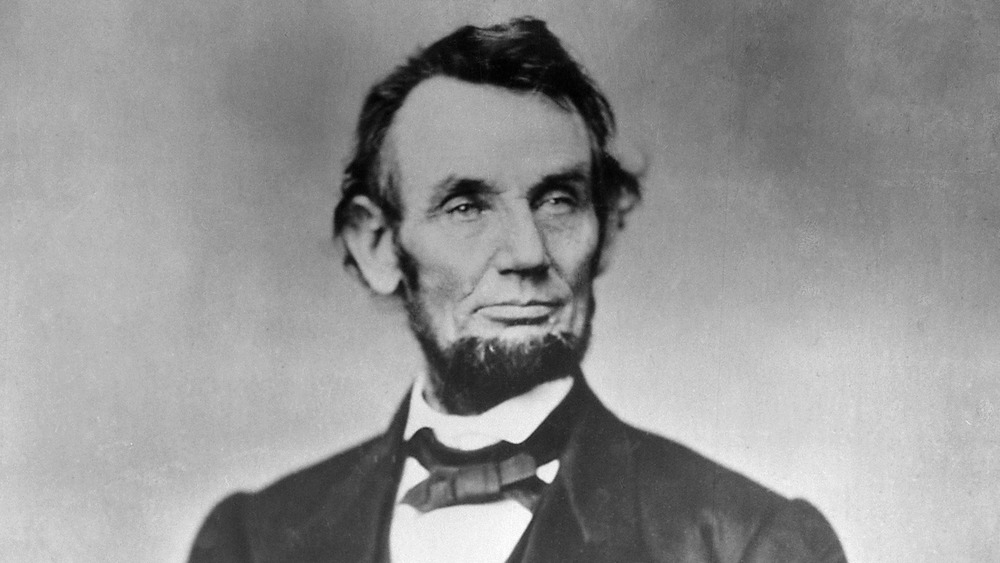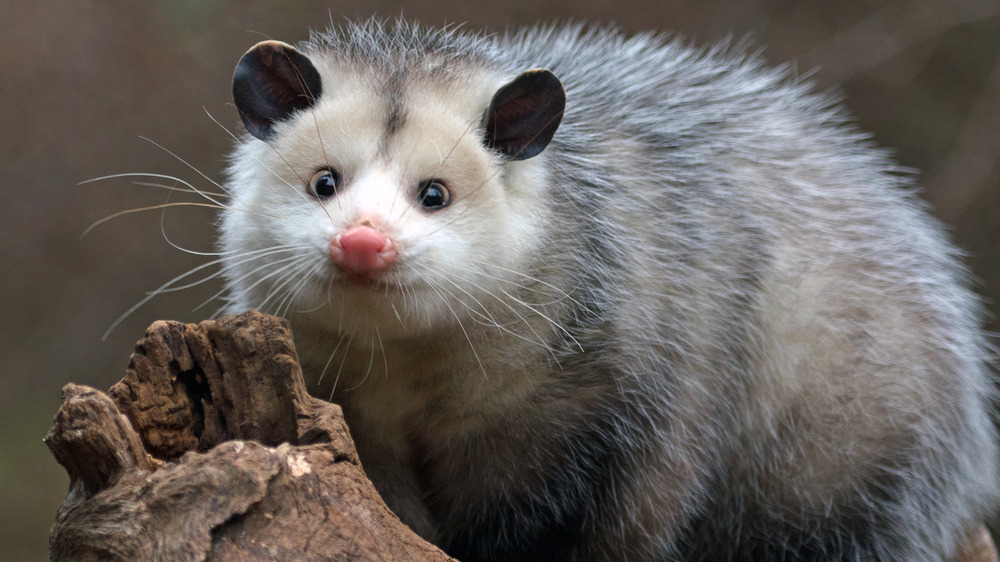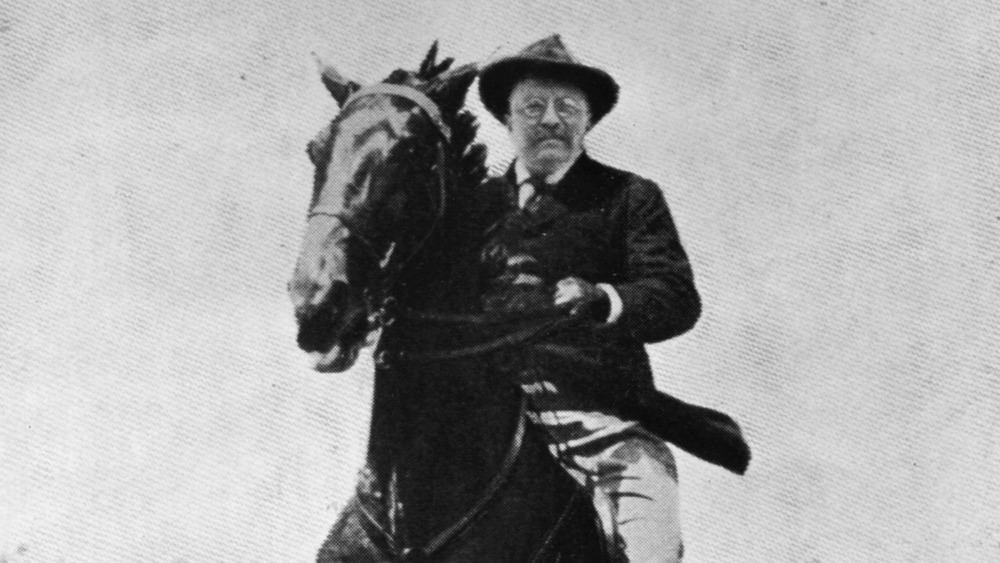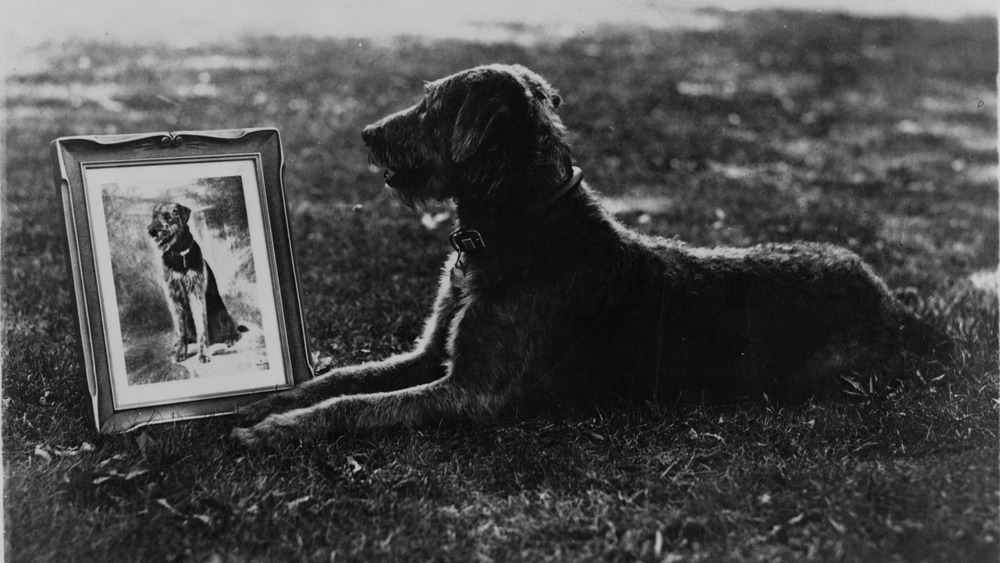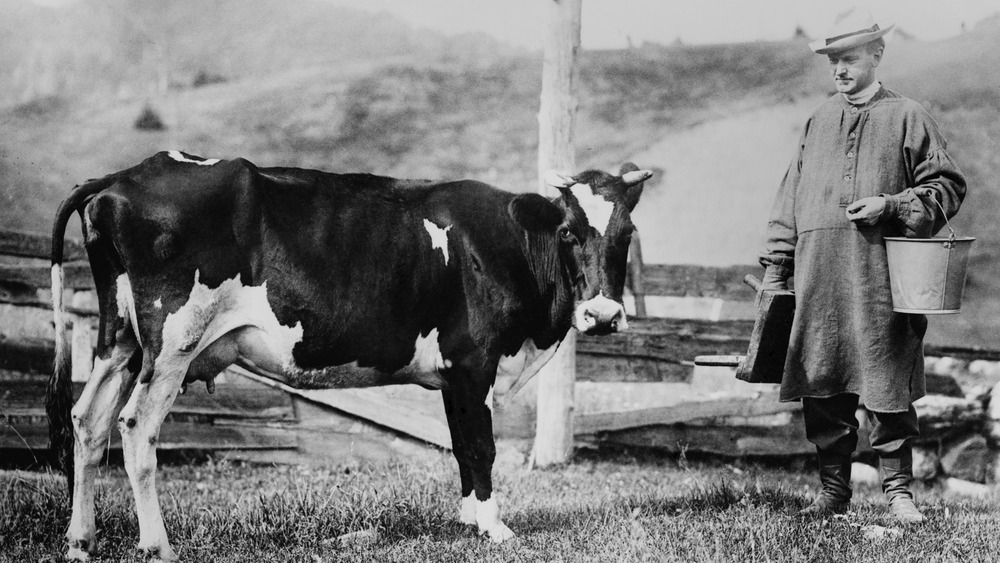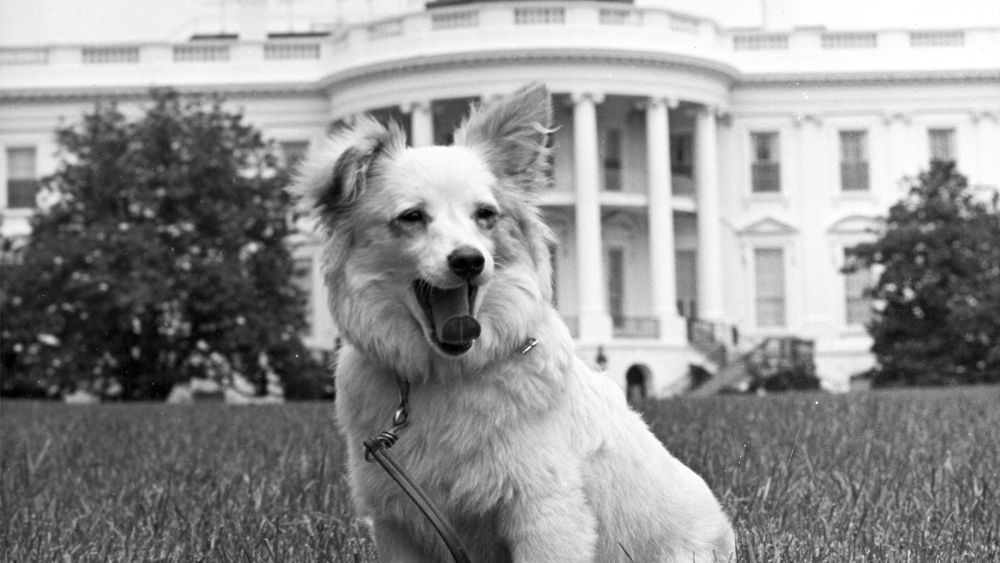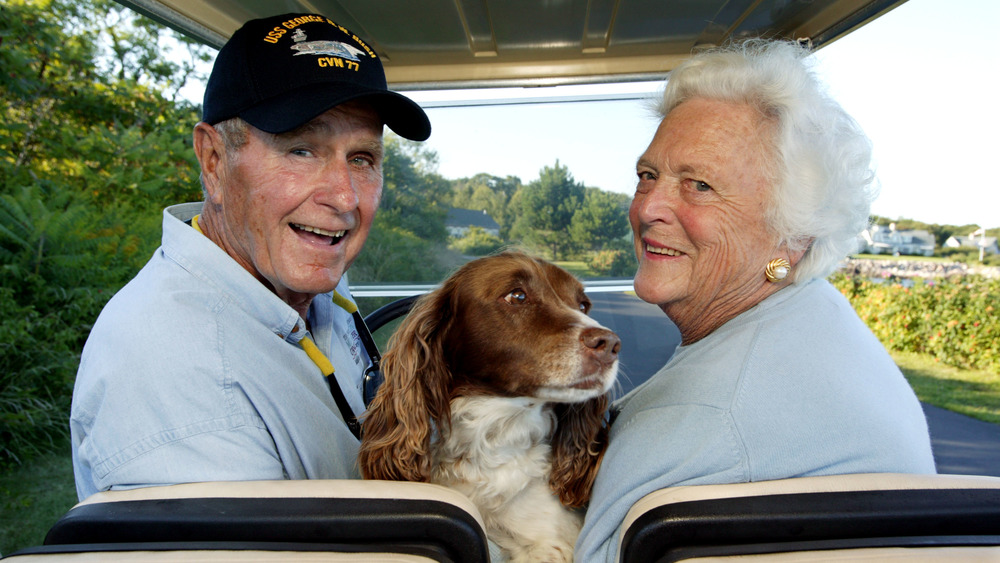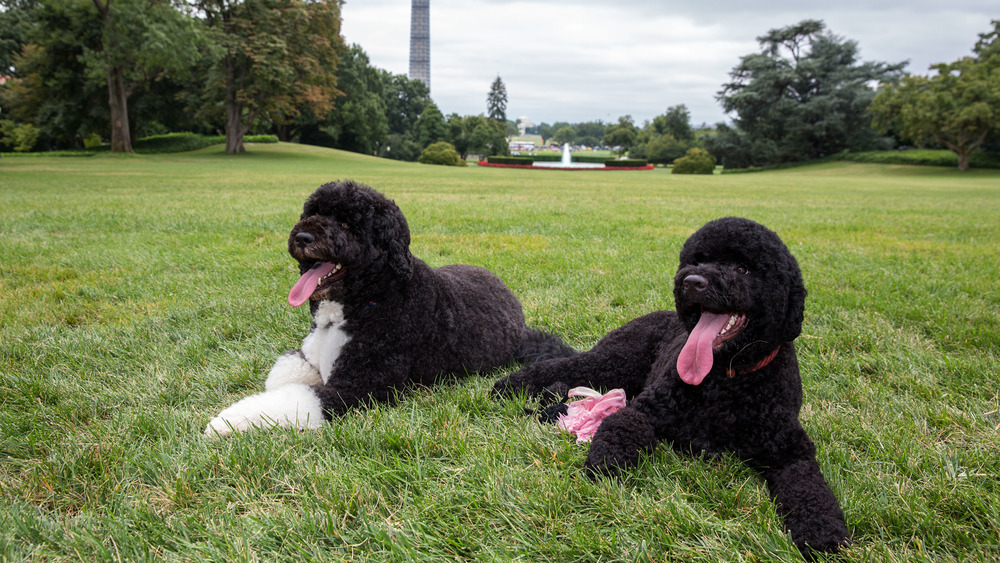The History Of Pets In The White House
To say that Americans love their pets is a colossal understatement. According to a 2018 article from CNBC, Americans spent $72 billion on their animal pals in 2018 alone, with that figure expected to expand in coming years. Although some critics may argue that the American pet obsession is unhealthy and part of a wider problem with socialization in the 21st century, the benefits of pet ownership are unquestionable. According to the Centers for Disease Control and Prevention, pet owners generally enjoy lower blood pressure, lower cholesterol levels, and decreased feelings of depression and loneliness.
Given that pets are proven stress relievers, it's no surprise that most American presidents have shared the White House with a faithful dog, cat, or other animal friend. Long acknowledged as one of the most difficult and demanding jobs on Earth, the presidency's unique challenges have made pets nearly a requirement for the job. Only a handful of presidents such as Donald Trump, the first president in 130 years to not own a pet, have taken up the task of commander-in-chief without a loyal animal by his side. At times, a president may find that a pet is the only nonpartisan friend he has outside the Beltway, lending a weight to Will Rogers' famous quote, "I love a dog. He does nothing for political reasons."
Read on to learn more about the history of the animals that have made the White House a home.
The first White House pets belonged to John Adams
Although George Washington, an avid fox hunter who kept horses and a bevy of hounds with such off-the-wall names as Sweet Lips, Drunkard, and Tippler, was the first United States president, he never lived in the White House. The first animals to occupy the presidential home belonged to Founding Father, political philosopher, and second U.S. President John Adams. Taking office in 1797, Adams first served as vice president to Washington before his election to the presidency. A thoughtful man noted for his diplomatic skills, Adams was no hunter or horseman.
Adams and his wife Abigail moved into the unfinished White House in 1800, just four months before the end of his term. According to The Presidential Pet Museum, the Adamses brought with them a horse named Cleopatra, the first to reside in the White House stables. Cleopatra, Adams' favorite horse, along with another horse named Caesar, had pulled the president's carriage to his Philadelphia inauguration.
Adams also brought along several mixed-breed dogs, which would be the first to run the White House lawn. Although there is little information extant about the Adamses' dogs, we know that two of the president's favorites were named Juno and Satan. Abigail Adams was apparently very fond of Juno. In a letter to her granddaughter, Caroline Smith de Windt, Abigail Adams wrote, ". . . If you love me . . . you must love my dog."
Thomas Jefferson's mockingbirds and bears
Third president and primary author of the Declaration of Independence Thomas Jefferson defeated Federalist John Adams in the 1800 presidential election. Among his first duties was to sell off the carriages, horses, and livery left to him by Adams. A Democratic-Republican, Jefferson shrugged off notions of pomp and pageantry, and, obviously, a horse-drawn carriage seemed to him an extravagance for a king, not an elected servant of the people. Still, animals would play an important role in the Jefferson White House.
Jefferson had an affinity for mockingbirds and owned several over his life. However, his journals and letters refer only to one by name. As detailed by the website of Jefferson's famous residence Monticello, Dick, Jefferson's favorite mockingbird, resided in a cage "suspended among the roses and geraniums in the window recesses of the presidential cabinet." When alone, Jefferson would often open Dick's cage and let him fly about the White House.
Jefferson would also briefly become caretaker of the first exotic pets to live in the White House. In October of 1807, explorer Capt. Zebulon Pike sent two grizzly bear cubs to the president as a gift. In a letter to his niece, Jefferson wrote of his decision to donate the cubs to the museum of his friend Charles Willson Peale, citing that the animals were "too dangerous and troublesome to keep." Nevertheless, the bears remained at the presidential residence for months and were eventually set loose on the White House lawn when they outgrew their cage.
Andrew Jackson's profane pet parrot
One of America's most controversial presidents, Andrew Jackson is equally admired and reviled. A tough-talking military man known for his aggressive political tactics, Jackson was a veteran of the Revolutionary War who characterized himself as a defender of the rights of the common man. Nevertheless, his role in the removal of Native Americans from their land has made his reputation and legacy problematic.
Jackson was a skilled equestrian and a horse racing fanatic. After assuming office in 1829, Jackson uprooted his Nashville stables and relocated them to Washington D.C., transforming the White House grounds into a full-fledged racehorse breeding and training operation. Thruxton, one of his most beloved racehorses, was the subject of one of Jackson's many duels when the owner of a competing horse failed to pay up after forfeiting a race.
Jackson's favorite non-racing horse, a white stallion he called Sam Patch, was named for an early American daredevil famous for leaping into Niagara Falls. Although the original Sam Patch is largely forgotten, his four-legged namesake is immortalized in a painting on display at Jackson's former home, the Hermitage, in Tennessee.
Jackson's most notorious pet, an African grey parrot named Poll, never lived at the White House. Purchased for his ailing wife, Rachel, Poll remained at the Hermitage during Jackson's term. Infamous for its use of profane language, the bird was removed from Jackson's funeral when it unleashed a torrent of curse words in front of shocked mourners.
Martin Van Buren was the original Tiger King
The first president born a U.S. citizen, Martin Van Buren took over in the Oval Office in 1837. Standing only five feet six inches, Van Buren, known as the "little magician," previously served as both vice president and secretary of state under Jackson. Inheriting the aftermath of Jackson's dissolution of the Second Bank of the United States, Van Buren was faced with the Panic of 1837, one of the worst economic downturns in American history, just three months into his only term. The ensuing depression and resultant unemployment caused many of Van Buren's constituents to turn on him, earning him the nickname "Martin Van Ruin."
Not a passionate horseman like his predecessor, Van Buren nonetheless enjoyed riding and maintained the White House stables. However, a pair of unconventional pets landed the eighth president in hot water with Congress. According to the Presidential Pet Museum, Kabul al Said, the Sultan of Oman, gave the president two tiger cubs. Thrilled with the animals, Van Buren immediately made preparations to house them at the White House. Congress was less enthusiastic about the cubs. Citing the fact that the cubs had been shipped while Jackson was still president, Congress declared the animals property of the U.S. government and demanded Van Buren relinquish his pets to authorities. Despite his vehement demands that the tigers be kept at the White House, the cubs were confiscated and placed in a local zoo,
Lincoln's pets brought him peace
If ever any president needed the calming influence of a faithful pet, it was Abraham Lincoln. While shepherding a fractured nation through the dark days of the Civil War, Lincoln often found solace in his animal companions.
Lincoln's love and compassion for animals is legendary. He had a special fondness for cats and was the first president to bring felines to the White House. As detailed by the website Mr. Lincoln's White House, Treasury official Maunsell B. Field wrote of Lincoln's affinity for cats in his memoirs. "(Lincoln) was fond of dumb animals, especially cats," Field stated. "I have seen him fondle one for an hour. Helplessness and suffering touched him when they appealed directly to his senses, or when you could penetrate through his intelligence to them." Lincoln was known to talk to his cats Dixie and Tabby (given to him by Secretary of State William Seward) for hours on end and once declared that Dixie was "smarter than his whole cabinet."
The beleaguered president Lincoln was also fond of his dog Jip. Jip, a small dog of indeterminate breed, became part of the Lincoln family when their excitable dog Fido's demeanor was determined unsuitable for the White House. Jip was allowed to roam freely throughout the presidential home but was partial to the president's lap.
Lincoln's White House was also home to ponies, rabbits, a turkey, and a pair of rambunctious billy goats that Lincoln's son Tad would occasionally drive through the East Room.
Benjamin Harrison's billy goat and opossum pals
Benjamin Harrison took the reins of the executive branch 1889. The grandson of ninth U.S. president William Henry Harrison, Benjamin Harrison served a single term between Grover Cleveland's two nonconsecutive administrations. An advocate for civil rights, education, and veteran's issues, Harrison signed the Sherman Antitrust Act of 1890, one of the country's first monopoly-busting laws. The end of Harrison's term saw the country's budget surplus dwindle and the economy slide into depression. Consequently, he was not reelected.
Harrison brought many members of his family into the White House, including his father-in-law, his two adult children and their spouses, and his grandchildren. With this brood came a plethora of pets. Several mixed-breed dogs occupied the Harrison White House. The most well-known was Dash, a mixed-breed collie Harrison gave to his grandchildren. Dash lived in a lavish doghouse on the grounds of the presidential home.
The Harrison grandchildren also had an ornery goat by the name of Old Whiskers. The spirited animal often ferried the children around the White House grounds in a cart. On one occasion, the goat with Harrison's grandchildren in tow, made a break for Executive Avenue through the open White House gates. The president himself comically raced after the runaway goat cart, top hat and cane in hand.
The most famous Harrison White House pets were two possums named Mr. Reciprocity and Mr. Protection. Taking their names from the Republican party platform, the beloved marsupials roamed freely through the White House.
Theodore Roosevelt's White House menagerie
Soldier, hunter, explorer, and conservationist, 26th U.S. President Theodore Roosevelt was a paragon of masculinity and macho bravado. As vice president, Roosevelt, only 42 years old, assumed the presidency upon the assassination of William McKinley, making him the youngest president in U.S. history. A popular president, Roosevelt instituted a vigorous foreign policy that helped make the U.S. a world power. In 1906, he became the first American president to win the Nobel Peace Prize due to his efforts to end the Russo-Japanese War.
As a lover of nature and all around "man's man," it comes as no surprise that Roosevelt had a White House menagerie as large as his personality. According to The Presidential Pet Museum, the Roosevelts had the largest collection of pets to ever occupy the White House. Along with numerous cats, dogs, guinea pigs, parrots, and horses, the Roosevelt pets included animals such as a flying squirrel, snakes, a hen, an owl, kangaroo rats, a lizard, a black bear cub named Johnathan Edwards, and a badger named Josiah given to the president by a 12-year-old girl during a railroad tour of the Western states.
While president, Roosevelt was also gifted many exotic animals from foreign governments. Among these animals were a wildcat, lion, and a zebra. Although most of these animals were quickly dispatched to zoos, at least one, a hyena who was fond of table scraps, occupied the White House for a brief time.
Warren G. Harding's dog was the White House's first celebrity pet
The White House has had its share of celebrity dogs, but the very first was Warren G. Harding's Airedale terrier, Laddie Boy. Although he wasn't Harding's only pet, he was by far the most famous. A constant presence during Harding's brief presidency, Laddie Boy frequently accompanied Harding on the golf course and sat for cabinet meetings in his own chair. First lady Florence Harding brought the famous canine along for fundraising events where he was always a crowd-pleaser.
According to Smithsonian Magazine, the media's obsession with the presidential pooch was such that he received nearly daily coverage in newspapers The Washington Star and The New York Times. In just over a month in 1921, Laddie Boy generated numerous headlines in the Times including, "Laddie Boy a Newsboy," "Trees White House Cat," and "Laddie Boy Gets Playmate."
Shortly after taking office, Harding had 1,000 bronze miniatures of Laddie Boy produced, which he handed out to constituents and friends. They are now among the most valuable of presidential collectibles.
The Hardings also kept a less famous but much loved bulldog named Old Boy, canaries, and a friendly squirrel named Pete. Pete, second in popularity to Laddie Boy, often attended press conferences and enjoyed being fed by hand.
Calvin Coolidge's Pennsylvania Avenue Zoo
When Warren G. Harding died unexpectedly of a heart attack just over two years into his term, Vice President Calvin Coolidge ascended to the Oval Office. A frugal man known for his quiet disposition, Coolidge presided over the booming 1920s.
Possessed of a conservative nature that characterized both his personality and his politics, Coolidge relegated any excessive tendencies to his love of animals. Rivaling Teddy Roosevelt's menagerie, the Coolidge White House was a veritable zoo with a bobcat, a goose, canaries, a wallaby, and a donkey all calling 1600 Pennsylvania Avenue home.
The Coolidges were particularly fond of dogs and had at least a dozen canines of various breeds including an Airedale terrier named Paul Pry, a half-brother of Warren Harding's star pet Laddie Boy. Coolidge's favorite dog, however, was a white collie named Rob Roy. Rob Roy appeared often in public with the Coolidges and can be seen in a painting with first lady Grace Coolidge on display in the White House's China Room.
Another favorite Coolidge pet was a raccoon named Rebecca. Sent from Mississippi and intended to be part of the 1926 presidential Thanksgiving dinner, Rebecca received a reprieve from Coolidge, who immediately fell in love with the animal. As detailed by History.com, Rebecca was "a regular Houdini," who repeatedly escaped from her cage much to the consternation of White House staff.
The Kennedys and a Cold War canine in Camelot
President John F. Kennedy and his family were animal lovers whose taste in pets tended toward the conventional. Ponies, hamsters, a cat, parakeets, a canary, a rabbit, and five dogs all kept the Kennedys company at the White House.
The most famous Kennedy pet, however, was Pushinka. A mutt, Pushinka (Russian for "fluffy"), was a gift from Soviet Premier Nikita Khrushchev. In a 2014 interview with the BBC, Caroline Kennedy recalled how her mother Jacqueline Kennedys's attempt at small talk led to Pushinka's arrival. "She was sitting next to Khrushchev at a state dinner in Vienna. She ran out of things to talk about, so she asked about the dog, Strelka, that the Russians had shot into space," Kennedy said. "During the conversation, my mother asked about Strelka's puppies." A few months later, Pushinka, one of Strelka the space dog's pups, arrived at the White House.
According to biographer David Heyman, author of American Legacy: The Story of John and Caroline Kennedy, Pushinka was given to aggressive behavior from time to time. Once when little Caroline Kennedy was out with her nanny, Maud Shaw, Pushinka growled at the toddler. Heymann writes, "Instead of recoiling, Caroline stepped behind the dog and gave it a swift kick to the rear end. Emitting a howl, Pushinka turned tail and raced off into the night." When the president caught wind of the incident, he smiled at his daughter and quipped, "That's giving it to those damn Russians!"
President George H.W. Bush's dog "wrote" a bestseller
Without a doubt, one of the most famous White House dogs of all time belonged to 41st President George H.W. Bush and first lady Barbara Bush. Millie, an English springer spaniel named for Mildred Caldwell Kerr, a longtime friend of the Bushes, captured the imagination of the American public like no first pet since Warren Harding's Laddie Boy and has since come to be known as "the most famous dog in White House history."
In 1990, Millie made the headlines when she "wrote" the children's book, Millie's Book: As dictated by Barbara Bush, in which the presidential pooch details her daily routine and thoughts about life in the White House. The book reached number one on the New York Times Bestsellers List.
President Bush frequently referenced Millie in speeches — most memorably in an October 1992 campaign speech in which he stated that Millie knew more about foreign policy than Bill Clinton and Al Gore.
President Obama's canine pets Bo and Sunny
When President Barack Obama first embarked on his campaign for the presidency in 2007, he promised his daughters, Sasha and Malia, a dog if he won. In April of 2009, the first daughters got their wish when Sen. Ted Kennedy gave the Obamas a Portuguese water dog named New Hope. Quickly renamed Bo, the pup became a social media star and the subject of several children's books. In an excerpt from his memoir A Promised Land published in Town and Country, Obama cites his evening walks with Bo as essential to his emotional well-being at the White House.
Sunny, another Portuguese water dog, joined Bo in the White House in 2013. The first canines were the subject of a dognapping plot in early 2016. The perpetrator, a North Dakota man named Scott D. Stockert, who claimed to be the illegitimate son of John F. Kennedy and Marilyn Monroe, was nabbed by the Secret Service.
